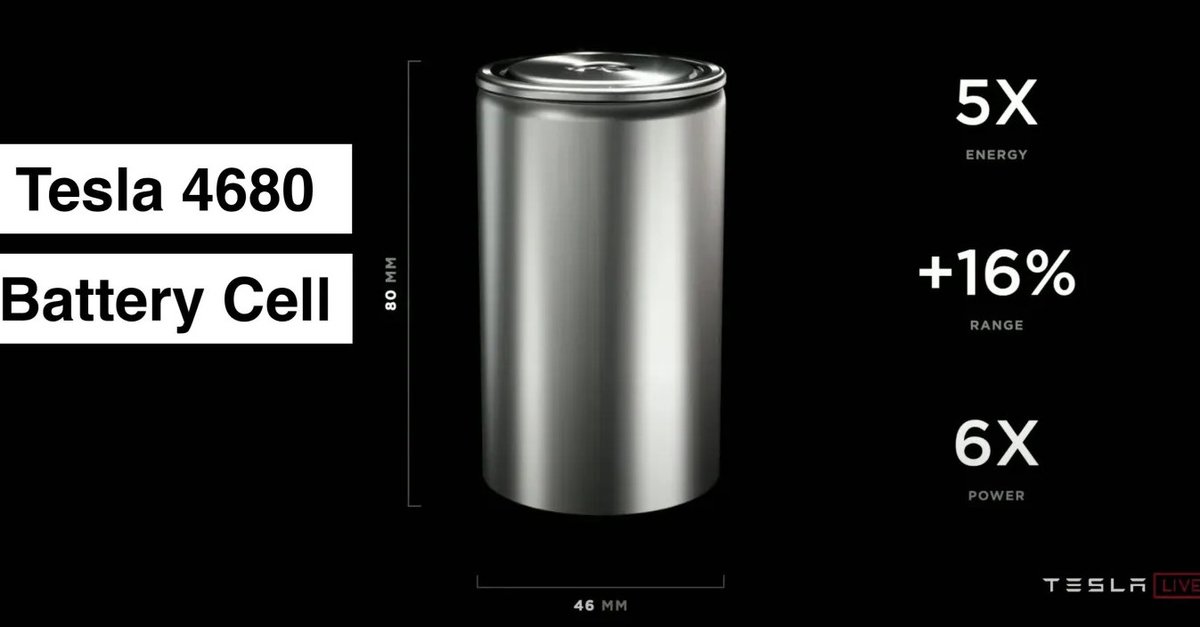Tesla battery: This is the 4680 battery
In September 2020, Elon Musk, Tesla boss and Twitter buyer, introduced the new 4680 battery. Better value for money, higher output with faster loading times, improved safety and environmental friendliness were promised. But what exactly distinguishes the battery from other rechargeable batteries and what is the truth behind the promises?
When some technique sounds too good to be true, there’s usually a catch. 2 years after the announcement, the 4680 battery is finally being installed in cars. This guide will tell you what you need to know about the battery.
4680 battery: That’s what’s behind it
First the name of the battery: This describes the size of the battery. With a diameter of 46 millimeters and a length of 80 millimeters, the cell is considerably larger than the 2170 batteries previously used. This means that fewer cells have to be combined than before, since the individual cells have a higher storage capacity. follow from this lower costs for production and assembly, since fewer work steps are required.
In addition, the battery integrated into the chassis of the carwhich enables better handling of the vehicle, but at the same time makes it more difficult to repair individual components (source: medium.com).
The problem with the 4680 battery: NMC 811
However, size shouldn’t be the only differentiator in the announcement. The battery should originally have about a different cell chemistry than conventional lithium-ion batteries.
If you need a brief overview of how the galvanic cell and battery work per se, we have the perfect guide for you:
On the one hand, the anode, i.e. the negative pole, should be made of silicon, an idea that was celebrated at the time of the announcement. However, it turns out that these made of graphite and thus hardly differs from previous batteries. Except for one detail: With modern anodes, 10 to 15 percent silicon is added to increase the energy density and capacity. These are missing with the 4680 apparently (source: insideevs.de). Silicon stores far more lithium ions than graphite and also has a lower resistance.
On the other hand, the cathode, i.e. the positive pole of the cell, consists of NMC811 – 80 percent off Nicky, 10 percent Manan and 10 percent Kobalt, which is mined under inhumane conditions and great damage to the environment (source: industriemagazin.at). A cell chemistry without cobalt with high proportions of manganese and less nickel was promised. Both nickel and cobalt are very expensive and the prices for the materials vary wildly. In addition, all three elements heavy metals and highly toxic, which puts additional strain on the environment.
4680 battery: many promises – huge disappointment
So there are only a few of the features that were praised in the sky when the announcement was made. The faster charging times or the higher energy density are also obsolete. On the contrary: the walls of the cells are considerably thicker than those of the smaller 2170 batteries. With that, the decreases energy density (Source: autoevolution.com).
In addition, Tesla is at the production apparently difficult. This is because Tesla wants to use dry electrodes instead of the wet process used up to now. So should batteries cheaper and more environmentally friendly are produced (source: leistungselektronik.de). When producing larger quantities, however, the quality goes downhill. Given the small amount that just barely makes it through quality testing, the cost per cell increases dramatically.
Despite everything, it seems like the production of the 4680 batteries is still progressing for Tesla worth. Once the problems with the drying process are solved, the price per cell could fall further (source: t3n.de). However, it is more likely that the Chinese manufacturer Catl Lead in battery development (Source: golem.de) continues to expand. This is also one of the leading manufacturers of lithium iron phosphate batteries.
If you have further questions about batteries, you should visit our mobility page.



